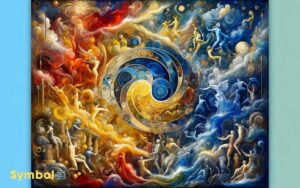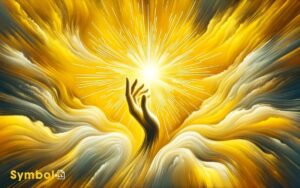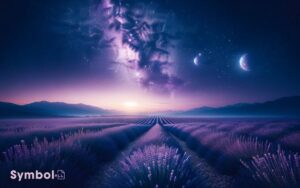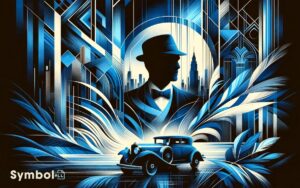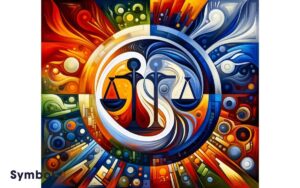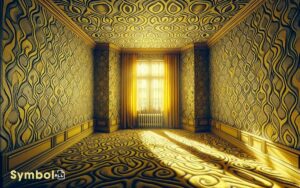What Does the Color Green Symbolize in the Great Gatsby
In ‘The Great Gatsby,‘ the color green epitomizes the complexity of the American Dream, intertwining wealth, hope, and the insatiable yearning for something just out of reach.
It’s the hue of envy, symbolizing Gatsby’s immense desire for Daisy and the materialistic world she represents.
Yet, it also stands for renewal and essential, mirroring the characters’ aspirations for transformation.
Most poignantly, the green light at Daisy’s dock embodies Gatsby’s eternal optimism and his pursuit of an unattainable dream, highlighting the gap between reality and desire.
This intricate symbolism paints a vivid picture of their collective quest, promising deeper insights into their fates and ideals.
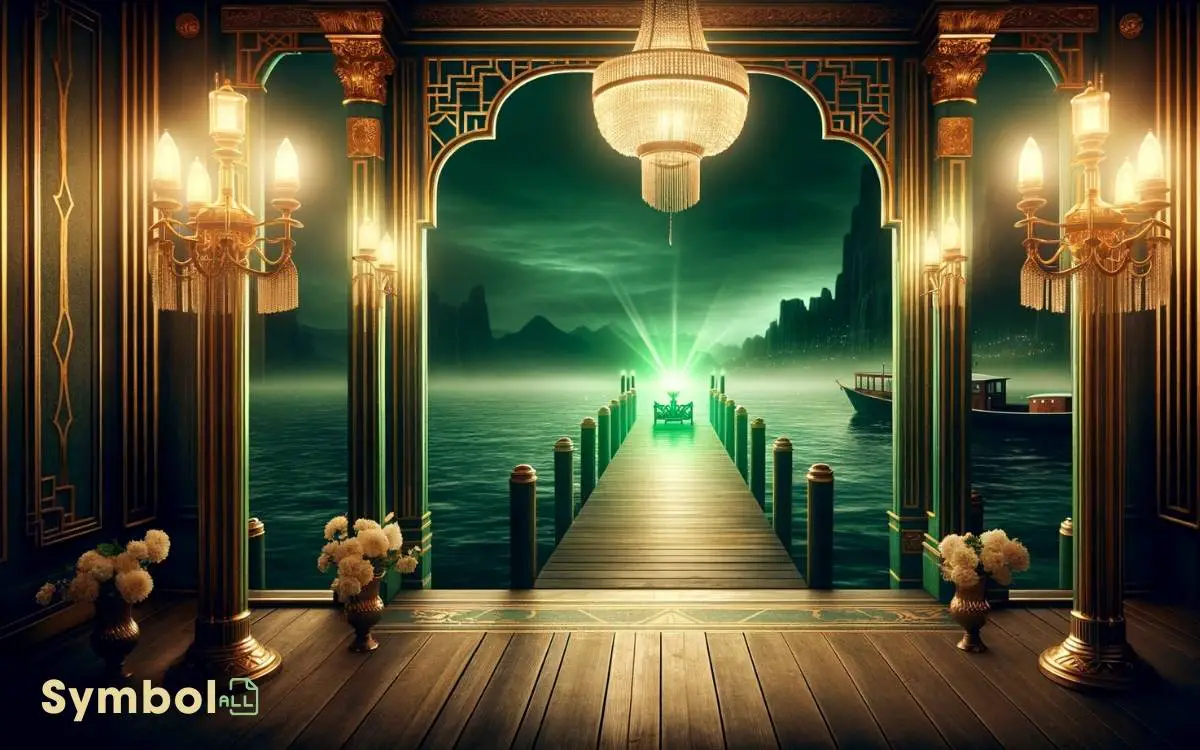
Key Takeaway
The Green Lights Allure
At the heart of The Great Gatsby, the green light symbolizes the elusive dream that Gatsby reaches for, embodying his longing and the broader American pursuit of happiness.
This beacon, not just a physical entity but a metaphor, illuminates the gap between reality and aspiration.
You see, Gatsby’s fixation on the light isn’t merely about recapturing the past or Daisy; it’s a reflection of his desire for a future that aligns with his ideals.
However, the color green also hints at the naivety and greed that underpin his ambitions. It’s a poignant reminder of the inherent contradiction in Gatsby’s quest: the more he reaches, the further he strays from genuine fulfillment.
Consequently, the green light serves as a multifaceted symbol, rich in meaning and implication.
Emblem of Hope
Beyond its allure, the green light also serves as a beacon of hope, illuminating Gatsby’s unwavering optimism amidst the desolation of his reality.
This singular symbol transcends its physical bounds, embodying the eternal hope that fuels Gatsby’s pursuit of Daisy.
It’s not just a light; it’s a manifestation of the American Dream, a promise of a better, more fulfilling future that keeps Gatsby reaching out into the darkness.
| Aspect | Symbolism | Effect on Gatsby |
|---|---|---|
| Green Light | Hope and the American Dream | Drives his pursuit |
| East Egg | Unattainable social status | Emboldens his resolve |
| Gatsby’s Parties | Desperate attempts at connection | Masks his loneliness |
| Daisy | Ultimate symbol of hope | Fuels his obsession |
This emblem of hope, though ultimately elusive, defines Gatsby’s character and underscores the novel’s exploration of the American Dream’s complexities.
Wealth and Envy
In ‘The Great Gatsby,’ the color green symbolizes not just hope, but also the darker sides of wealth and envy.
You’ll see how Gatsby’s obsessive desire for Daisy, fueled by his envy and the allure of her symbolic connection to wealth, embodies this complex symbolism.
This envy not only drives his actions but also highlights the corrosive nature of the American Dream when tainted by materialism.
Gatsbys Obsessive Desire
One can’t overlook Gatsby’s relentless pursuit of wealth and status, fueled by his envy and desire to win back Daisy’s love.
This obsession shapes much of the narrative and offers a critical lens through which to view his actions and motivations.
Consider the following aspects:
- Gatsby’s Ambition: His drive for opulence isn’t merely materialistic but a means to an emotional end – Daisy.
- Symbolic Green Light: It represents not just his dream of Daisy but also the broader American Dream, tainted by materialism.
- Envy as Motivation: Gatsby’s desire is twofold; to possess Daisy and to usurp the social status that keeps them apart.
- Facade of Success: His lavish parties and ostentatious displays of wealth are attempts to bridge the gap between his past and present, driven by his envy and desire.
Daisys Symbolic Allure
Daisy Buchanan captivates with her allure, embodying both the opulence and the envy that permeates ‘The Great Gatsby.’ You can’t help but observe how she’s enshrined in wealth, yet her charm sparks an insidious form of envy.
Through Daisy, Fitzgerald masterfully illustrates the corrosive effects of materialism and the green-eyed monster that it breeds.
| Aspect | Description | Symbolism |
|---|---|---|
| Green Light | Gatsby’s view of Daisy’s dock | Unattainable dream |
| Daisy’s Voice | Described as ‘money’ | Wealth’s seductive power |
| East Egg | Daisy’s residence | Old money, exclusivity |
| Gatsby’s Parties | Attempts to attract Daisy | Desperation, longing |
| Valley of Ashes | Between Gatsby and Daisy | Decay beneath wealth’s facade |
The American Dream
While delving into the symbolism of green in ‘The Great Gatsby,’ it’s essential to grasp how it intricately connects to the pursuit of the American Dream, mirroring the characters’ deep-seated desires for wealth, hope, and reinvention.
- Wealth: The color green often symbolizes money, reflecting the characters’ relentless chase for financial success.
- Hope: It embodies the eternal hope of achieving personal desires and the quintessential American optimism.
- Reinvention: Green signals the possibility of starting anew, mirroring Gatsby’s attempts to reshape his identity and past.
- Unattainable Desires: Finally, the green light represents the ever-distant nature of the American Dream itself, elusive and perpetually just out of reach, no matter the effort expended in its pursuit.
Nature and Vitality
You’ll find that in ‘The Great Gatsby,’ green isn’t just a color; it’s a vibrant symbol of nature, teeming with meanings of renewal, essence of life, and the promise of fertility and growth. It contrasts sharply with what blue represents in The Great Gatsby, often signifying melancholy, illusion, or unattainable dreams. While green reaches forward with hope, blue serves as a somber reminder of the distance between reality and aspiration. Together, these colors weave a complex emotional tapestry, enriching the novel’s exploration of longing and the human condition.
This hue embodies the relentless pulse of the natural world, suggesting that beneath the veneer of the Roaring Twenties lies a deeper yearning for a fresh start and the flourishing of life.
Fitzgerald uses green to remind you that amidst decay and disillusionment, the potential for rejuvenation and vitality remains ever-present.
Symbol of Renewal
In F. Scott Fitzgerald’s ‘The Great Gatsby,’ the color green frequently embodies the theme of renewal, symbolizing nature’s vitality and the characters’ longing for rejuvenation.
- Nature’s Cycle: Green represents the spring’s renewal, a metaphor for the characters’ desire for a fresh start. Their aspirations mirror the cyclical rejuvenation of nature itself.
- Gatsby’s Dream: For Gatsby, the green light isn’t just a symbol of his love for Daisy but also signifies his hope for renewal, to rewrite his past with her.
- Economic Rebirth: The color also hints at the era’s economic boom, suggesting a societal renewal and the American Dream’s revitalization.
- Personal Transformation: Each character’s interaction with the color green hints at their own quest for renewal, whether through love, wealth, or social status, revealing their deep-seated yearnings for transformation.
Essence of Life
Green, often symbolizing nature’s boundless energy, serves as a vivid reminder of life’s essence throughout ‘The Great Gatsby.’
Delving into Fitzgerald’s masterpiece, you’ll notice how green permeates scenes with vitality and the raw zest of existence.
This isn’t merely a backdrop; it’s a depiction in its own right, embodying the pulsating heartbeat of the world. It’s in the fresh lawns of East Egg, whispering of nature’s ever-present role, even amidst human-made opulence.
You see, green isn’t just a color in Gatsby’s universe—it’s an affirmation, a silent yet powerful confirmation of the enduring spirit of life that, despite the characters’ tribulations, remains untouched. It’s a constant, a beacon reminding them, and you, of the vibrant force that’s life itself.
Fertility and Growth
Fitzgerald skillfully intertwines the theme of fertility and growth into the narrative, symbolizing not only the natural world’s vitality but also the characters’ aspirations for renewal and prosperity.
This imagery isn’t just a backdrop but a crucial thread that connects the storyline, underscoring the pursuit of the American Dream amidst the decadence of the Jazz Age.
To help you explore further, consider these aspects:
- Gatsby’s lush, green gardens represent his hope and relentless pursuit of Daisy.
- The green light at the end of Daisy’s dock symbolizes Gatsby’s unattainable dreams, intertwined with growth and renewal.
- Spring motifs throughout the novel hint at rebirth and new beginnings, despite the characters’ tragic fates.
- The valley of ashes contrasts this fertility, highlighting the decay of moral values and the erosion of true growth.
Illusions of Love
Through the lens of green’s symbolism in The Great Gatsby, you’ll uncover how it paints the illusions of love, revealing desires that are as elusive as they’re alluring.
This color, often seen shimmering across the bay at Gatsby’s parties, represents not just a physical distance but an emotional chasm between Gatsby and his object of affection, Daisy.
It’s a visual metaphor for the dreams and aspirations that seem so close yet remain frustratingly out of reach.
The green light embodies the hope for a future that recedes as one advances towards it, mirroring the illusory nature of Gatsby’s romantic aspirations.
This motif invites you to reflect on the reality of love versus the idealized version that often exists only in our minds.
Gatsbys Obsession
Reflecting on the illusions of love highlighted by the color green, it’s imperative to examine Gatsby’s obsession, which serves as the driving force behind his elaborate façade.
This obsession not only shapes his identity but also defines his relationship with the world around him.
To truly understand Gatsby’s complex character, consider the following:
- His longing for Daisy: It’s not just love; it’s an idealized version of love that he can’t let go of.
- The green light: It symbolizes his relentless pursuit of this unattainable dream.
- His wealth accumulation: Every action towards gaining wealth is a step closer to Daisy, in his mind.
- His parties: Ostentatious displays meant to attract Daisy’s attention, not mere social gatherings.
These elements collectively reveal a man driven by an obsession that blurs the line between reality and illusion.
The Distance Between
The concept of distance in ‘The Great Gatsby’ intricately symbolizes the vast divide between Gatsby’s dreams and the harsh reality he faces. This gap isn’t merely physical but profoundly emotional and societal.
You see, Gatsby’s pursuit isn’t just about rekindling love but about transcending his past and societal status to achieve an idealized vision of himself.
The green light, emblematic of his aspirations, sits across the bay, a beacon of what could be but also a reminder of the spaces—social, economic, and existential—that he can’t bridge.
This distance is palpable in every attempt Gatsby makes to draw closer to Daisy, only to find the chasm widening, a poignant representation of the elusive nature of the American Dream itself.
Decay of Ideals
Examining ‘The Great Gatsby,’ it’s clear that the decay of ideals becomes a central theme, revealing how characters’ noble aspirations gradually erode under the weight of reality and personal flaws.
This theme is intricately woven through the narrative, making you question the cost of the American Dream.
- Gatsby’s Idealism: His pursuit of Daisy symbolizes a yearning for a past that can’t be recaptured, highlighting the futility of his dreams.
- Daisy’s Materialism: She embodies the shift from genuine affection to a life driven by material wealth, showcasing the erosion of personal values.
- Tom’s Hypocrisy: His moral decay reflects the larger societal corruption, challenging the integrity of the American aristocracy.
- Nick’s Disillusionment: His journey from an observer to a critic of the East Egg lifestyle signifies the loss of innocence and a deeper understanding of the human condition.
Conclusion
In F. Scott Fitzgerald’s ‘The Great Gatsby,’ the color green transcends mere hue, embodying aspirations and disillusionments akin to Tantalus’s unreachable fruit.
It’s the beacon of hope on Daisy’s dock, yet it’s also the shroud of envy, wealth, and the decaying American Dream.
Like Eden’s forbidden apple, it tempts Gatsby with illusions of love and vitality, only to underscore the unbridgeable distance between desire and reality, revealing the profound decay of his ideals.

